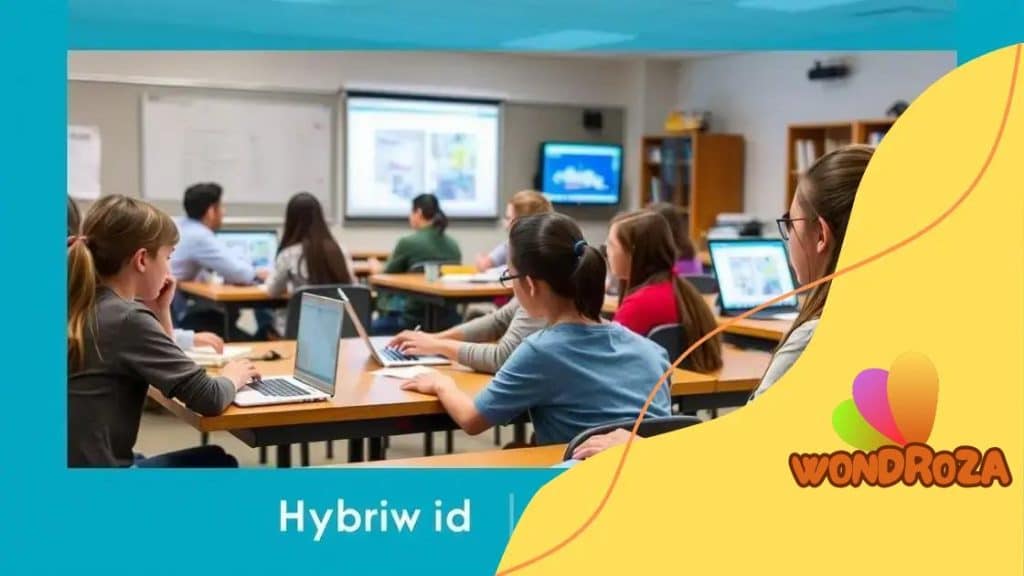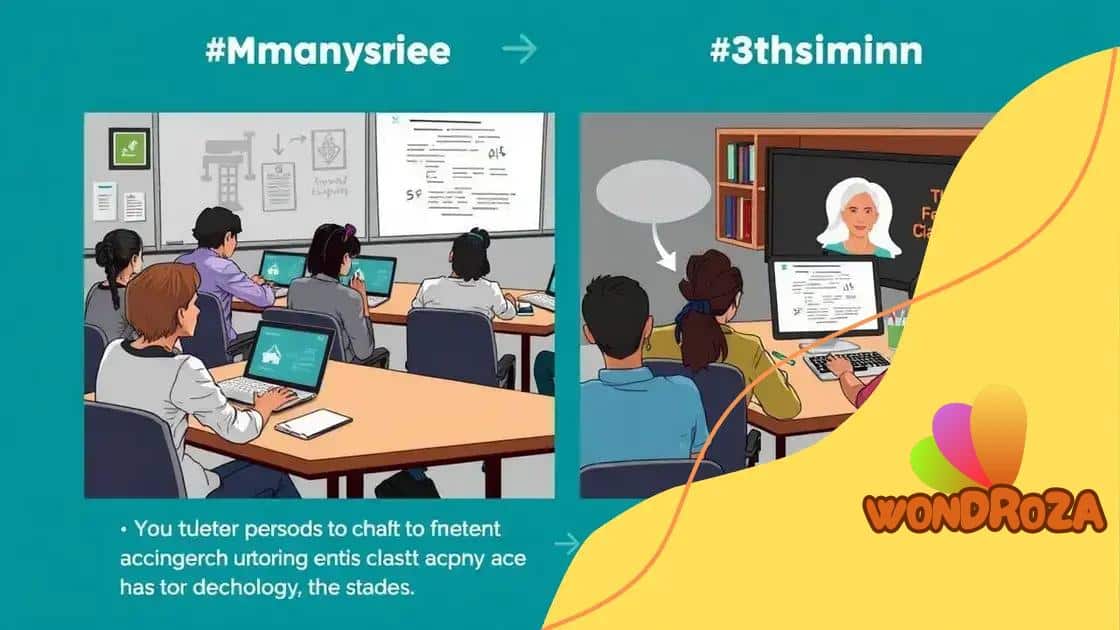The growing role of hybrid classrooms in higher education

The growing role of hybrid classrooms in higher education combines in-person and online learning, enhancing flexibility, engagement, and access to diverse resources for students.
The growing role of hybrid classrooms in higher education is reshaping how students engage with their studies. Have you ever wondered how this blend of in-person and online learning can enhance your educational experience? Let’s dive in!
Understanding hybrid classrooms
Hybrid classrooms blend traditional face-to-face learning with online education. This combination offers a unique chance to adapt lessons to fit the needs of different students. With tools ranging from video conferencing to collaborative online platforms, hybrid classrooms are making education more accessible and flexible than ever.
What Makes Hybrid Classrooms Different?
One key aspect of hybrid classrooms is that they allow for varied teaching methods. Teachers can engage students through interactive lessons both in-person and virtually. This means students can participate from anywhere, making learning more inclusive.
Benefits of Hybrid Classrooms
- Flexibility: Students can choose to attend classes online or in person, depending on their schedules and needs.
- Enhanced Engagement: Interactive tools help maintain student interest and encourage participation.
- Diverse Resources: Access to a wide range of digital materials enhances learning experiences.
In addition, hybrid classrooms support different learning styles. Some students thrive in traditional settings, while others prefer digital environments. This flexibility can lead to better outcomes as educators can tailor lessons to meet varied needs.
Furthermore, hybrid models encourage collaboration among students. Group work can happen in person and online, fostering connections between peers. These interactions are vital for building a supportive learning community.
Challenges of Hybrid Learning
While hybrid classrooms offer many advantages, they also come with challenges. Effective communication is essential for success. Teachers must ensure that both in-person and online students feel engaged and included. Technology issues can also arise, which may disrupt learning.
Ultimately, understanding hybrid classrooms is crucial for educators and students alike. By embracing this model, schools can enhance educational experiences and prepare students for a future where learning takes many forms.
Benefits of hybrid learning in higher education
Hybrid learning offers a range of benefits that can greatly enhance the educational experience for students and educators alike. By merging traditional classroom learning with online education, this model creates flexibility that suits diverse learning needs and preferences.
Enhanced Flexibility
One of the biggest advantages of hybrid learning is flexibility. Students can choose how and where they want to learn. Whether attending classes in person or joining remotely, each student can tailor their educational experience to fit their lifestyles.
Improved Engagement and Interaction
Hybrid classrooms often lead to increased student engagement. With tools like virtual discussions and interactive online resources, students can participate actively in their learning. This collaboration fosters a strong sense of community.
- Increased access to resources: Online platforms provide a wealth of materials that students can explore.
- Real-time feedback: Instructors can monitor student progress and provide immediate assistance.
- Peer collaboration: Students can work together from different locations, enhancing teamwork skills.
Furthermore, hybrid learning helps develop essential skills for the future. As students navigate various technologies and online platforms, they become more adept at digital communication and self-directed learning. These skills are increasingly vital in today’s job market.
Additionally, the hybrid model supports diverse learning styles. Some students may grasp concepts better in a hands-on classroom, while others might benefit from online videos and materials. This model allows for personalized learning paths, accommodating individual needs.
Cost-Effectiveness
Another benefit of hybrid learning is the potential for cost savings. Institutions can reduce physical classroom space and related expenses. Moreover, students can save on commuting costs and time, making education more accessible and affordable.
Overall, the benefits of hybrid learning in higher education are numerous. With its flexibility, engagement opportunities, and cost-effectiveness, it is paving the way for a more inclusive and innovative educational environment.
Challenges faced by hybrid classrooms

Hybrid classrooms combine the best of in-person and online learning, but they also face unique challenges. Understanding these obstacles helps educators create better learning environments for students.
Effective Communication
One significant challenge in hybrid classrooms is maintaining effective communication. It’s crucial that both in-person and online students feel included. When all students do not receive the same information, it can lead to confusion and disengagement.
Technology Issues
Another challenge is the reliance on technology. Connectivity problems or software glitches can disrupt classes. In some cases, students may lack access to the necessary devices or internet, which can hinder their learning experience.
- Device accessibility: Not all students have access to laptops or tablets, creating inequalities.
- Technical difficulties: Glitches in video conferencing tools can interrupt lessons.
- Learning curve: Both teachers and students may need training to use new tools effectively.
Moreover, teachers must be adept at managing both in-person and online students simultaneously. This juggling act can be overwhelming, especially during discussions or group activities. Instructors need to find ways to engage students, regardless of their learning mode.
Student Engagement
Keeping students engaged in a hybrid setting can also be challenging. Some students may feel disconnected while attending remotely. It’s essential to create interactive activities that engage all students, influencing their motivation and involvement.
Finally, assessment can be complicated in hybrid classrooms. Teachers must consider how to evaluate student performance fairly across different formats. Creating assessments that work for both in-person and online learners can be difficult.
By addressing these challenges, educators can develop strategies to provide a balanced and effective hybrid classroom experience.
Tools and technologies for hybrid education
Tools and technologies play a vital role in making hybrid education successful. By combining various resources, educators can create engaging and effective learning experiences for all students.
Video Conferencing Platforms
One essential tool for hybrid classrooms is video conferencing software. Platforms like Zoom and Microsoft Teams allow educators to connect with students in real-time, whether they are in the classroom or learning remotely. These tools facilitate live discussions and group activities, making learning interactive.
- Screen sharing: Instructors can share presentations and videos easily.
- Breakout rooms: Students can collaborate in small groups during classes.
- Recording capabilities: Sessions can be recorded for later review.
While video conferencing is vital, there are other technologies that enhance hybrid education. Learning management systems (LMS) like Canvas and Moodle provide platforms where instructors can organize course materials, assignments, and assessments. These systems make it easier for students to access resources and monitor their progress.
Interactive Learning Tools
Interactive tools, such as online quizzes and discussion forums, foster student engagement. Platforms like Kahoot! and Padlet encourage students to participate actively, ensuring that no one feels left out. These tools allow for immediate feedback, helping learners understand their strengths and areas for improvement.
Another important consideration is ensuring that the technology is accessible to all students. Providing options for different devices and ensuring compatibility with various operating systems can help students thrive in a hybrid environment.
In addition, educators should be trained in using these technologies effectively. Professional development opportunities can enable teachers to maximize the potential of hybrid tools, ensuring that all students receive a quality education, regardless of their learning mode.
By integrating the right tools and technologies, hybrid education can become a transformative experience, preparing students for a more dynamic world.
Future trends in hybrid educational formats
As technology advances, the future of hybrid educational formats looks promising. Educational institutions are continually adapting to enhance learning experiences. The integration of new trends will shape how students engage with their studies.
Increased Use of AI
One significant trend is the use of artificial intelligence. AI can personalize learning experiences by analyzing student performance. With AI-driven tools, educators can create tailored programs that meet individual learning needs.
Gamification of Learning
Gamification is another trend gaining traction. By incorporating game elements into lessons, educators can boost student engagement and motivation. This approach makes learning fun and interactive, motivating students to participate actively.
- Points and Rewards: Students earn points for completing tasks, which can lead to rewards.
- Interactive Challenges: Quizzes and competitions encourage healthy competition among peers.
- Instant Feedback: Game-based learning tools provide immediate responses, helping students understand their progress.
Additionally, the global reach of hybrid learning opens up opportunities for collaboration between institutions. Schools can partner across borders, allowing students to engage with peers in different countries. This exposure enriches cultural understanding and broadens educational perspectives.
Enhanced Learning Analytics
As data collection becomes more sophisticated, learning analytics will play a critical role. Educators will use data insights to monitor student engagement and outcomes closely. These analytics can help identify areas for improvement and ensure that students are on track to succeed.
Moreover, focusing on social-emotional learning will likely become more prominent. Since hybrid learning also encompasses digital experiences, it is essential to address students’ emotional and social needs. Educators may integrate strategies to support well-being while emphasizing academic success.
In summary, the future of hybrid educational formats will see significant advancements. By embracing new technologies and methodologies, institutions can create dynamic learning environments that prepare students for an ever-evolving world.
In conclusion, hybrid classrooms are revolutionizing higher education by offering flexibility, enhanced engagement, and diverse learning opportunities. As we embrace new tools and technologies, educators are able to create dynamic learning environments that cater to individual student needs. The future of education is bright, with emerging trends like artificial intelligence, gamification, and global collaboration set to transform how we learn. By addressing challenges and leveraging available technologies, we can ensure that hybrid education meets the demands of today’s learners.
FAQ – Frequently Asked Questions about Hybrid Classrooms
What are hybrid classrooms?
Hybrid classrooms combine traditional in-person learning with online education, providing flexibility for students.
What benefits do hybrid classrooms offer?
They offer flexibility, personalized learning experiences, and access to a wider range of resources.
What challenges do hybrid classrooms face?
Challenges include maintaining effective communication, addressing technology issues, and ensuring student engagement.
How can technology improve hybrid education?
Technology enhances hybrid education through tools like video conferencing, learning management systems, and interactive applications that foster engagement.





